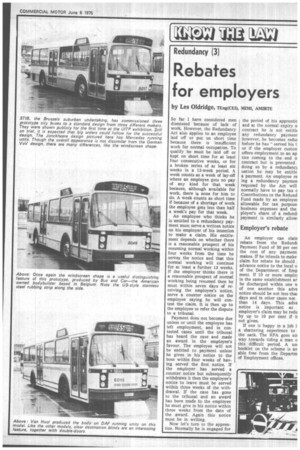Redundancy (3)
Page 71

If you've noticed an error in this article please click here to report it so we can fix it.
Rebates for employers
by Les Oldridge, TEng(CEI), MIMI, AMIRTE
So far I have considered men dismissed because of lack of work. However, the Redundancy Act also applies to an employee laid off or put on short time because there is insufficient work for normal occupation. To qualify he must be laid off or kept on short time for at least four consecutive weeks, or for a broken series of at least six weeks in a 13-week period. k week counts as a week of lay-off where an employee gets no pay of any kind for that week because, although available for work, there is none for him to do. A week counts as short time if because of a shortage of work the employee gets less than half a week's pay for that week.
An employee who thinks he is entitled to a redundancy payment must serve a written notice on his employer of his intention to make a claim. His entitlement depends on whether there is a reasonable prospect of his resuming normal working within four weeks from the time he serves the notice and that this normal working will continue for at least a further 13 weeks. If the employer thinks there is a reasonable prospect of normal working being resumed then he must within seven days of receiving the employee's notice, serve a counter notice on the employee saying he will contest the claim. It is then up to the employee to refer the dispute to a tribunal.
Payment does not become due unless or until the employee has left employment, and in contested cases until the tribunal has heard the case and made an award in the employee's favour. The employee will not be entitled to payment unless he gives in his notice to the boss within four weeks of having served the first notice. If the employer has served a counter notice but subsequently withdraws it then the employee's notice to leave must be served within three weeks of the withdrawal, If the case has gone to the tribunal and an award has been made to the employee he must give in his notice within three weeks from the date of the award. Again this notice must be in writing.
Now let's turn to the apprentice. Normally he is engaged for the period of his apprentic and at the normal expiry o contract he is not entitlE any redundancy payment however, he becomes redut before he has " served his t or if the employer custon offers employment to an ap tice coming to the end o contract but is prevented doing so by a redundancy uation he may be entitle a payment. An employee re ing a redundancy paymen required by the Act will normally have to pay tax c Contributions to the Redund Fund made by an employet allowable for tax purpose. business expenses and the player's share of a redund: payment is similarly allow.
Employer's rebate
An employer can clain rebate from the Redund( Payment Fund of 50 per cen the cost of any payment makes. If he intends to make claim for rebate he should advance notice to the local o of the Department of Emp ment. If 10 or more emplo! in the same establishment at be discharged within one w of one another this adva notice should be not less that days and in other cases not than 14 days. This adva notice is important as employer's claim may be redu by up to 10 per cent if it not given.
If one is happy in a job i a shattering experience to the sack. The RPA goes soi way towards tiding a man o this difficult period. A USE booklet on the scheme is av able free from the Departm of Employment offices.


















































































































